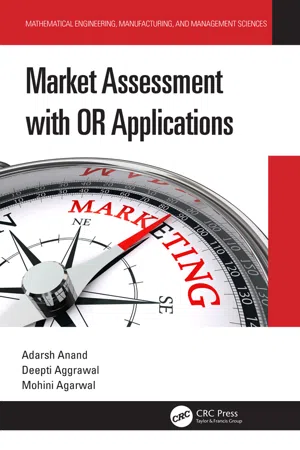
- 108 pages
- English
- ePUB (mobile friendly)
- Available on iOS & Android
Market Assessment with OR Applications
About This Book
This book provides an understanding of the concept of marketing and its role in business and public organization including the need for scientific marketing analysis.
It includes a variety of mathematical models applied for better decision making, promotional decisions in the presence of competition, and sales forecasting using an Operational Research (OR) approach. The book also provides a platform to academicians, practitioners, and researchers to gain understanding of marketing management concepts from an OR perspective.
This book offers relevant, international perspectives on techniques for market assessment under one canopy. It will be helpful for those who want to gain insight into understanding the managerial aspects from an OR analyst point of view and is a collaboration that contains plenty of related and valuable techniques used in real-life problems faced by industries.
Frequently asked questions
1 Introduction to Marketing Management
1.1 Concept of Marketing
- Considering consumer wants as top objectives.
- Mobilizing the entire firm to meet the challenges.
- Long-term profit rather than short-term goals.
1.2 Role of the Marketing Manager
- Managers strive to discover, entice, maintain and develop a loyal customer base by providing high-value products or services.
- Managers play a crucial role in determining the potential market and the people who will be served, their nature and the level of need the products can satisfy.
- Managers assist the top management in developing sound plans and policies.
- Managers coordinate various activities related to production, procurement, packaging and even promotional campaigns.
- Mangers generate ideas for new products or services to satisfy the growing needs of the consumer.
- Managers develop a strategy that can differentiate their offering from that of their competitors.
1.3 Marketing Orientation
1.4 Product and Selling Concept
1.5 Types of Marketing
- Co-marketing: a partnership between two or more companies that jointly market each other’s products, e.g. a company that manufactures video cards may partner with a game software company and both will market each other’s related product.
- Viral marketing: in internet and online advertising, viral marketing is a type of marketing technique that relies on and encourages people to pass along a message by word of mouth marketing. In viral marketing, online user blogs and social networks are used to produce positive word of mouth brand awareness.
- Online marketing: it refers to a set of powerful tools and methodologies used for promoting products and services through the internet. It includes a wider range of marketing elements than traditional business marketing because of extra channels and marketing mechanisms available on the internet. It connects organizations with qualified potential customers and takes business development to a much higher level than traditional advertising. Further, it combines the internet’s creative and technical tools, including design, development, sales and advertising, while focusing on e-commerce, lead-based websites, affiliated marketing and so on.
- Green marketing: this kind of marketing tactic is being adopted and practiced by all of the firms that are committed to sustainable development or corporate social responsibility (CSR). It can also be defined as the selling of products or services based on environmental factors and also made from renewable materials which can be recycled and which are not using excessive packaging materials.
- Rural marketing: as the name itself implies that marketing which is concentrated in catering to rural markets. This terminology is similar to marketing, the difference being the target population. Here the market specifically consists of rural regions. Thus, it is the application of basic of marketing to the rural sector of the economy.
- Service marketing: this is a special branch of marketing aiming to build relationships and value. This kind of marketing pedagogy can be adopted for both products and services. As the larger part of the economy is dependent on the service industry this type of marketing is the need of the hour.
1.6 Problems for Self-Assessment
- Explain the concept of marketing.
- Distinguish between the product and the selling concepts.
- Discuss the market orientation view from a consumer perspective.
- Explain the role of the marketing manager.
- Differentiate between rural and service marketing.
References
2 Need for Scientific Marketing Analysis
2.1 Decision-Making: A Quantitative Approach
- What are the long-term objectives of the organization, how t...
Table of contents
- Cover
- Half Title
- Series
- Title
- Copyright
- Dedication
- Contents
- Preface
- Acknowledgments
- Author Biographies
- 1 Introduction to Marketing Management
- 2 Need for Scientific Marketing Analysis
- Chapter 3 Understanding the Consumer’s Perspective
- Chapter 4 Product and Brand Management
- Chapter 5 Pricing Decision: A General Perspective
- Chapter 6 Some Purchasing Policies Under Fluctuating Pricing
- Chapter 7 Distribution Management
- Chapter 8 Promotional Management Using OR Concepts
- Index